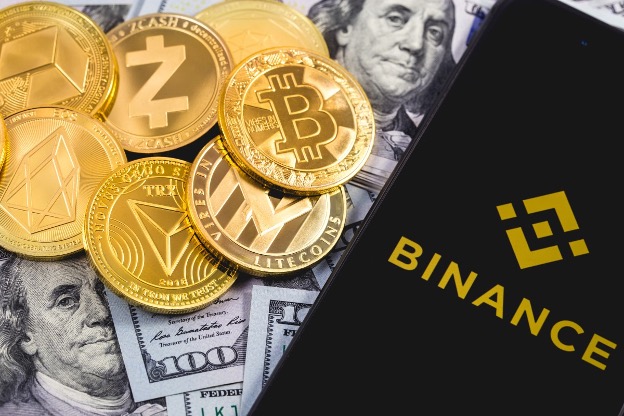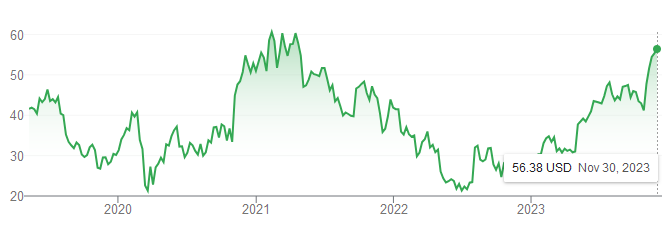
You’ve probably read the headlines about the $4.3 billion fine that Binance – the world’s largest crypto exchange – has agreed to pay the U.S. government.
In my view, it’s worth every penny.
With this fine, Binance has essentially bought its freedom. Binance is now legit.
I have not read a single article that explains clearly what the deal means for crypto users – especially investors in the Binance token (BNB). (Full disclosure: I’m an investor.)
Here’s what happened, and what it means for the coming age of crypto.
A Brief History of Binance
Binance was founded in 2017, during the heyday of crypto. Initial Coin Offerings were all the rage, when entrepreneurs would launch a new crypto company, mint new tokens to raise money (just like issuing shares in an IPO), then use the proceeds to build the company.
Bitcoin was reaching new all-time highs, new tokens were launching every day, and a new class of “crypto trader” sprung up to provide liquidity between all these digital assets: buying, selling, and occasionally hodling them for the long-term.
 Changpeng (“CZ”) Zhao, a developer who worked on trading software for the Tokyo Stock Exchange, started Binance in the midst of this maelstrom. With Binance, users could buy, sell, and trade all the major cryptocurrencies, with Binance getting a cut out of each transaction.
Changpeng (“CZ”) Zhao, a developer who worked on trading software for the Tokyo Stock Exchange, started Binance in the midst of this maelstrom. With Binance, users could buy, sell, and trade all the major cryptocurrencies, with Binance getting a cut out of each transaction.
It was a money-printing machine.
In the beginning, it was easy to open an account without providing much identification, which attracted both legitimate customers (by the millions) and illegitimate customers (the occasional money launderer, ransomware scammer, and terrorist financer.)
Where Binance erred was in not implementing stricter customer checks, sooner: as the Department of Justice has documented, CZ prioritized growth of the company above compliance with the law.
The company helped “VIP customers” (crypto whales moving a lot of money and generating hefty profits), even when their behavior seemed sketchy. And Binance seemed to know that money was illegally flowing between the U.S. and sanctioned countries like Iran.
In CZ’s defense, the company spun off a subsidiary called Binance.US in 2019, blocking U.S. users from the Binance.com platform and redirecting them to Binance.US instead. The idea was that Binance.US would adhere to the more stringent U.S. regulations.
The problem, according to the DOJ, was that determined U.S. users could still use Binance.com through a VPN or proxy tool, so the bad behavior continued … and Binance knew about it.
Meanwhile, CZ made it a point to establish Binance in a kind of no-man’s-land, getting rid of any physical headquarters, and constantly staying on the move. He asked employees to use encrypted messaging services, so there was no paper trail.
When the U.S. government began turning up the heat in 2021, CZ resisted, but eventually the threat of a massive lawsuit changed his thinking. He had just seen how a run on FTX crippled the company and landed Sam Bankman-Fried in prison. (In fact, he helped FTX crash and burn.)
If it came to an FTX-style trial, customers might get spooked and withdraw all their funds, and that really would be the end of Binance. (It was also in the government’s best interest to settle: remember how the contagion from the FTX collapse spilled over to traditional banks as well.)
So Binance and the U.S. government came to a deal.
The Deal, Explained
In plain English: U.S. customers will not be allowed to trade on Binance.com, and the government will appoint compliance monitors to audit and ensure that Binance is behaving, for real this time.
U.S. customers will still be allowed to use Binance.US (if you’re reading this from the U.S., you can try Binance.com and Binance.US for yourself). Binance.US will, of course, be more closely monitored for compliance, which should be a good thing for customers.
CZ will step down as CEO, to be succeeded by Richard Teng, a former CEO of Abu Dhabi’s financial services regulator. CZ still maintains his ownership stake in Binance, though he is giving up voting rights.
And then there’s that pesky $4.3 billion fine. ($4,316,126,163, to be exact.) Binance claims it had set aside up to $8 billion for an eventual settlement, so apparently they were saving for a rainy day.
The news media keeps saying Binance is making a “complete exit” from the United States, which is inaccurate. U.S. customers are some of Binance’s most valuable. They’re critical for the long-term growth of the company.
To be clear, U.S. users cannot use Binance.com, but they can continue to use Binance.US. Which is the same way it’s been since 2019, only now with better compliance. But saying “Things remain exactly the same at Binance” does not make for a great headline.

The Investor Takeaway
I am supremely bullish on this turn of affairs.
I don’t condone breaking the law, so I think Binance was absolutely wrong to help criminals get around their controls. When you build a company culture around skirting the edges of the law, it’s hard to wash that out of your system. That worries me.
On the other hand, I learned a lesson from watching the rise of Uber under its founder Travis Kalanick. Here was another disruptive technology company breaking into a heavily-regulated market. At the time, taxis were terrible, and Uber truly provided a better customer experience. Under Kalanick, Uber played hardball to win new markets, often skirting or flouting the law.
We should all feel conflicted about these moral dilemmas. Is it right or wrong for an enterprising entrepreneur to aggressively promote a better product — even if it means breaking laws that might be outdated or unfair?
In the case of Uber, the taxi industry was ripe for disruption, Uber was a far superior product, and society benefited as a result. (In fact, I took a NYC taxi the other day, and was astonished at how much better the taxi experience has become – it’s a lot like taking an Uber.)
Binance legitimately provides great products and services. It’s one of the most user-friendly, trustworthy crypto exchanges in the world. It keeps funds secure. It continually innovates, from high-yield staking products to its own blockchain. It even has its own charity.
Would the company have become successful if it waited for U.S. regulators to catch up? The SEC still cannot even define whether a token is or is not a security. If you want to see the results of the “wait and see” approach, just look at U.S. banks. No crypto innovation.
For me, this settlement allows the DOJ to score a political win, lets Binance play nice with the government, and releases the entire industry to move forward.
This is why I am very pleased about Binance’s $4.3 billion fine. The company can afford it, and now there is an understanding in place. The U.S. government will monitor Binance, they’ll appoint a grownup CEO, and the company is now legit.
(Remember, Uber ultimately ousted Travis Kalanick and brought in a grown-up CEO in Dara Khosrowshahi. The company launched an IPO and now its stock price is approaching all-time highs.)

I’ll repeat those four important words: Binance is now legit. This is a huge deal. It’s worth every penny of the $4.3 billion.
My belief is that investing in the BNB token is like investing in Binance. Now that Binance is “government approved,” my view is that the company will not only survive, but thrive. They have great products, an enormous competitive moat, and now they’re officially regulated.
For my money, BNB is a better buy than ever.
Want to make your crypto investments work even harder for you? Subscribe to our Bitcoin Market Journal newsletter!
- SEO Powered Content & PR Distribution. Get Amplified Today.
- PlatoData.Network Vertical Generative Ai. Empower Yourself. Access Here.
- PlatoAiStream. Web3 Intelligence. Knowledge Amplified. Access Here.
- PlatoESG. Carbon, CleanTech, Energy, Environment, Solar, Waste Management. Access Here.
- PlatoHealth. Biotech and Clinical Trials Intelligence. Access Here.
- Source: https://www.bitcoinmarketjournal.com/binance-fine-explained/



